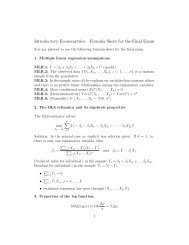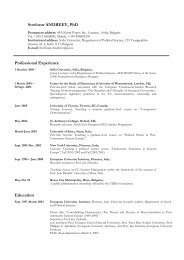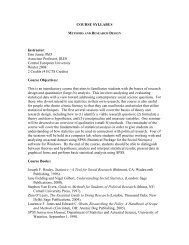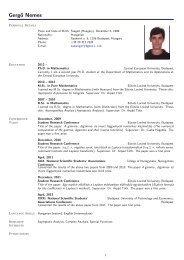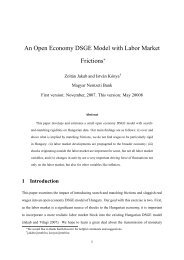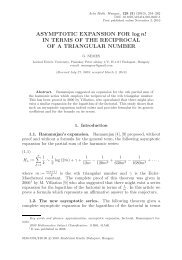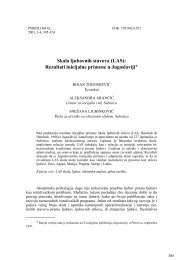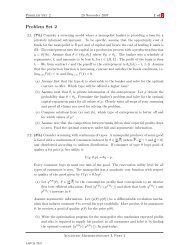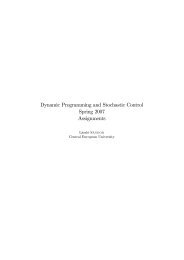Testing Gateway Theory: do cigarette prices affect illicit drug use?
Testing Gateway Theory: do cigarette prices affect illicit drug use?
Testing Gateway Theory: do cigarette prices affect illicit drug use?
Create successful ePaper yourself
Turn your PDF publications into a flip-book with our unique Google optimized e-Paper software.
682 M. Beenstock, G. Rahav / Journal of Health Economics 21 (2002) 679–698<br />
The solution to this problem is to instrument C t−1 in Eq. (1). No <strong>do</strong>ubt Z and X largely<br />
overlap. An element of Z is the price of <strong>cigarette</strong>s (and other variables discussed in Section 4)<br />
that prevailed when individual n was growing up (P n(t−1) ), which are hypothesized to<br />
determine the demand for <strong>cigarette</strong>s but not the demand for cannabis. We expect C t−1 to<br />
vary inversely with P t−1 . There is no reason to suspect that P t−1 and v t−1 are correlated<br />
(nor P t−1 and u t ). If S t <strong>do</strong>es not depend upon P t−1 , then P t−1 identifies the effect of C t−1<br />
upon S t in Eq. (1).<br />
The next step in the gateway chain concerns the relationship between cannabis and<br />
hard <strong>drug</strong>s. The hypothesis of interest here is <strong>do</strong>es exposure to cannabis induce a higher<br />
probability of subsequently using hard <strong>drug</strong>s? We denote H n = 1 if individual n <strong>use</strong>d hard<br />
<strong>drug</strong>s after using cannabis and 0 otherwise. We express this as follows:<br />
H n(t+1) = λY n(t+1) + δS nt + ρ y D y + w n(t+1) (3)<br />
where Y is a vector of controls for hard <strong>drug</strong> <strong>use</strong>. <strong>Gateway</strong> <strong>Theory</strong> suggests δ>0. Since<br />
we suspect that E(wu) >0 unobserved heterogeneity is likely to bias upwards estimates<br />
of δ. Ideally, we seek exclusion restrictions for Y and X such as <strong>drug</strong> price data, which are<br />
not available in Israel. Instead, we suggest using as an instrument for S t in Eq. (3) its fitted<br />
value from IV estimation of Eq. (1). We refer to this as “<strong>do</strong>mino” identification beca<strong>use</strong><br />
the natural experiment is indirect. Clearly, such indirect identification weakens the power<br />
of tests on the value of δ. Ran<strong>do</strong>m exposure to <strong>cigarette</strong>s at time t − 1 induces cannabis<br />
consumption at time t, which in turn, induces hard <strong>drug</strong> <strong>use</strong> at time t + 1. If β and δ are<br />
properly identified, and there is a causal gateway effect, we can expect a chain reaction<br />
where raising the price of <strong>cigarette</strong>s will reduce <strong>cigarette</strong> smoking, which will reduce the<br />
subsequent <strong>use</strong> of cannabis, which, in turn, will reduce the subsequent <strong>use</strong> of hard <strong>drug</strong>s.<br />
Note that Eqs. (1)–(3) control for cohort effects. This is possible beca<strong>use</strong> we <strong>use</strong> several<br />
surveys in Section 4 (y = year of survey − age). Had there been only one survey it would<br />
not have been possible to identify the separate effects of P t−1 and birth cohort upon <strong>drug</strong><br />
consumption.<br />
2.2. Recursive bivariate probit and two-stage procedures<br />
If u and v in Eqs. (1) and (2) happen to be bivariate normal with cov(u, v) = ρ then<br />
the model may be estimated by maximum likelihood as a recursive bivariate probit (RBP)<br />
model (Maddala, 1983, pp. 122–123, Greene, 2000, pp. 852–825). Note that in this case C in<br />
Eq. (1) <strong>do</strong>es not have to be instrumented beca<strong>use</strong>, in contrast to the linear probability model,<br />
it is not estimated by least squares. However, Maddala points out that identification requires<br />
that X omit covariates in Z.IfX = Z the model is not identified, even parametrically.<br />
Maddala suggests that an alternative procedure is to specify prob (C ∗ > 0) in Eq. (1)<br />
instead of C, where C ∗ denotes the underlying latent variable that measures the propensity<br />
to smoke <strong>cigarette</strong>s. In this case, it may be shown that a two-stage procedure provides<br />
consistent estimates of the parameters in Eqs. (1) and (2). In the first stage, Eq. (2) is<br />
estimated by probit or logit, and in the second stage the predicted probability of C obtained<br />
from the first stage is <strong>use</strong>d to replace C in Eq. (1).<br />
There are advantages and disadvantages to both procedures. The main disadvantage of<br />
RBP is that it may be sensitive to parametric assumptions about the unobserved heterogeneity.



